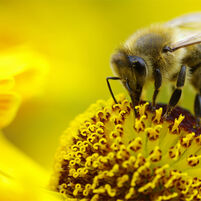Pesticides and bees: guidance review


EFSA has reviewed its guidance document on the risk assessment of plant protection products and bees (Apis mellifera, Bombus spp. and solitary bees), which was originally published in 2013 but never endorsed unanimously by Member State representatives on the European Commission’s Standing Committee for Plants, Animals, Food and Feed.
Endorsement by Member States is needed for the guidance to be applied during the scientific assessments conducted with respect to the approval and renewal of approval of active substances used in pesticides.
In 2019, the European Commission (EC) and Member States asked EFSA to review the guidance, taking into account new scientific knowledge that has emerged since 2013. The reviewed guidance therefore contains the most up-to-date methodologies for conducting risk assessments for honey bees, bumble bees and solitary bees.
The review was carried out by a working group consisting of EFSA staff and external experts. Throughout the process EFSA consulted Member States via the Pesticide Steering Network and a range of stakeholders via a dedicated stakeholder group. EFSA also took part in a series of workshops and information sessions hosted by the EC for Member State representatives and stakeholders. Documents related to these meetings can be found in the Milestones section below.
Furthermore, the European Chemicals Agency (ECHA) and EFSA have cooperated to harmonise approaches for assessing risks to bees under the plant protection products and biocidal products regulations.
Between July and October 2022, EFSA held a public consultation on the draft guidance document. The revised guidance was published in May 2023. More background information on the guidance review is available on the EC website.
Latest
EFSA has published its revised guidance on the risk assessment of plant protection products on bees (Apis mellifera, Bombus spp. and solitary bees). To provide more information on the guidance review and the work behind, EFSA organised a public online info session on 13 June 2023.
Milestones
2024
February
ECHA publishes guidance to assess the risks to bees from the use of biocides.
2023
March
EFSA finalises its guidance update on the risk assessment of plant protection products and bees.
2022
October
Following the closure of EFSA’s public consultation on its revised guidance for the risk assessment of plant protection products and bees, EFSA and the European Commission organised a workshop with representatives of the Member States and stakeholders. The workshop held on 5 October 2022 provided an opportunity for participants to discuss their comments on the draft guidance update and possible ways to address them.
July
EFSA launches a public consultation on its revised guidance on the risk assessment of plant protection products and bees, covering honey bees, bumble bees and solitary bees, which ran until 3 October.
January
EFSA publishes a document to support risk managers in their decision whether to establish specific protection goals (SPGs) for wild bees. The document – requested by the European Commission – provides an overview of the available data and tools, considers existing approaches for SPGs in the area of ecotoxicology, and highlights knowledge gaps.
2021
November
Preliminary work carried out on the supporting document on wild bees is presented to the stakeholder group and Member State experts at a special information session organised by the European Commission.
Information session for the stakeholder group to explain how specific protection goals for honey bees will be implemented in the risk assessment.
June
The European Union’s Agriculture and Fisheries Council (Agrifish) establishes an SPG of 10% as the maximum permitted level of colony size reduction resulting from exposure of honey bees to pesticides.
March
EFSA’s working group publishes a method for defining specific protection goals (SPGs) for honey bees on the basis of the background variability of colony sizes. EFSA developed the document in response to a request from risk managers to provide scientific background to support them in their decision-making process about what needs to be protected and to what extent.
2020
December
EFSA publishes a second document to support risk managers in setting SPGs for bees. The document lays out an approach for deriving a threshold of acceptable effects on colony size based on background variability.
September
Information session held to give the stakeholder group a progress report on the revision of the guidance document.
July
A comprehensive analysis of the available scientific evidence on bee mortality is carried out. The report is based on the largest systematic collection of evidence on mortality rates ever conducted, and covers the three bee groups – honey bees, bumble bees and solitary bees.
June
EFSA publishes a supporting document offering risk managers a choice of four approaches to reviewing the SPGs – i.e. the threshold of acceptable effects – for bees.
March
Stakeholder group and Member States consulted to gather feedback on the draft protocol on for the GD revision.
2019
November
Consultation with the stakeholder group, experts from Member States, and with the bee guidance working group to gather input on the draft protocol on data collection on bee background mortality.
July
Consultation with stakeholder group and Member State experts to collect initial thoughts on the revision of the guidance document.
May
The European Commission asks EFSA to review the guidance on risk assessment of pesticides and bees, which was published in 2013. EFSA establishes a scientific working group to carry out the review, supported by a stakeholder consultative group. The group is being consulted at various stages during the review and providing input to the working group.